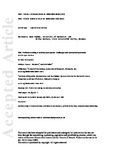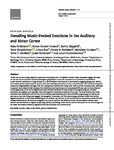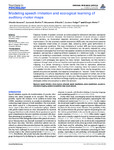Predictive coding in auditory perception: challenges and unresolved questions
| dc.contributor.author | denham, susan | |
| dc.contributor.author | Winkler, István | |
| dc.date.accessioned | 2018-01-11T15:37:14Z | |
| dc.date.available | 2018-01-11T15:37:14Z | |
| dc.date.issued | 2020-03 | |
| dc.identifier.issn | 0953-816X | |
| dc.identifier.issn | 1460-9568 | |
| dc.identifier.uri | http://hdl.handle.net/10026.1/10562 | |
| dc.description.abstract |
<jats:title>Abstract</jats:title><jats:p>Predictive coding is arguably the currently dominant theoretical framework for the study of perception. It has been employed to explain important auditory perceptual phenomena, and it has inspired theoretical, experimental and computational modelling efforts aimed at describing how the auditory system parses the complex sound input into meaningful units (auditory scene analysis). These efforts have uncovered some vital questions, addressing which could help to further specify predictive coding and clarify some of its basic assumptions. The goal of the current review is to motivate these questions and show how unresolved issues in explaining some auditory phenomena lead to general questions of the theoretical framework. We focus on experimental and computational modelling issues related to sequential grouping in auditory scene analysis (auditory pattern detection and bistable perception), as we believe that this is the research topic where predictive coding has the highest potential for advancing our understanding. In addition to specific questions, our analysis led us to identify three more general questions that require further clarification: (1) What exactly is meant by prediction in predictive coding? (2) What governs which generative models make the predictions? and (3) What (if it exists) is the correlate of perceptual experience within the predictive coding framework?</jats:p> | |
| dc.format.extent | 1151-1160 | |
| dc.format.medium | Print-Electronic | |
| dc.language | en | |
| dc.language.iso | eng | |
| dc.publisher | Wiley | |
| dc.subject | auditory object representation | |
| dc.subject | auditory scene analysis | |
| dc.subject | computational modelling | |
| dc.subject | pattern detection | |
| dc.subject | Acoustic Stimulation | |
| dc.subject | Auditory Cortex | |
| dc.subject | Auditory Perception | |
| dc.subject | Sound | |
| dc.title | Predictive coding in auditory perception: challenges and unresolved questions | |
| dc.type | journal-article | |
| dc.type | Journal Article | |
| dc.type | Research Support, Non-U.S. Gov't | |
| dc.type | Review | |
| plymouth.author-url | https://www.ncbi.nlm.nih.gov/pubmed/29250827 | |
| plymouth.issue | 5 | |
| plymouth.volume | 51 | |
| plymouth.publication-status | Published | |
| plymouth.journal | European Journal of Neuroscience | |
| dc.identifier.doi | 10.1111/ejn.13802 | |
| plymouth.organisational-group | /Plymouth | |
| plymouth.organisational-group | /Plymouth/REF 2021 Researchers by UoA | |
| plymouth.organisational-group | /Plymouth/REF 2021 Researchers by UoA/UoA04 Psychology, Psychiatry and Neuroscience | |
| plymouth.organisational-group | /Plymouth/Research Groups | |
| plymouth.organisational-group | /Plymouth/Research Groups/Centre for Brain, Cognition and Behaviour (CBCB) | |
| plymouth.organisational-group | /Plymouth/Research Groups/Centre for Brain, Cognition and Behaviour (CBCB)/Brain | |
| dc.publisher.place | France | |
| dcterms.dateAccepted | 2017-11-20 | |
| dc.identifier.eissn | 1460-9568 | |
| dc.rights.embargoperiod | Not known | |
| rioxxterms.versionofrecord | 10.1111/ejn.13802 | |
| rioxxterms.licenseref.uri | http://www.rioxx.net/licenses/all-rights-reserved | |
| rioxxterms.licenseref.startdate | 2020-03 | |
| rioxxterms.type | Journal Article/Review |




